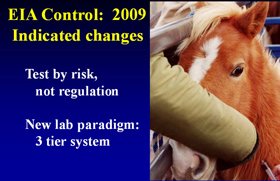TOPICS
- Home
- Challenges
- EIA Virus
- Transmission NEW!!
- Persistent Infection
- Pathogenesis
- Immune Response
- Diagnosis & Control
- Field Studies
- Publications NEW!!
- Links
- Contact and Credits
HOT TOPICS IN EIA RESEARCH
Hot Topics in EIA Research
International Activities
Our team has been asked to participate in control of outbreaks of EIA in various parts of the world over the years. Currently, Dr. Frank Cook is working to perfect methods to be able to identify EIAV in the blood of equids across the globe. The methods involve using sensitive PCR (polymerase chain reaction) techniques with "universal primers" to permit amplification of EIAV strains with a variety of sequences, expected with this virus with a high mutation rate.
We have generated reference materials for use in diagnosis of EIA. Recently, the EIAV proteins of our laboratory reference strain have been found useful in immunoblot assays with equid blood samples from several European countries, including Ireland and Italy. These immunoblot tests proved useful in their outbreaks in 2006 and continue to be used as confirmation of field samples from EIA suspect equids.
In February of 2009, Dr. Jenner K P Reis joined our laboratory as a visiting scientist for 12 months. Dr. Reis has returned to his faculty position at the Federal University of Minas Gerais at Belo Horizonte in Brazil where his research team continues to investigate a variety of diseases caused by retroviruses (please see his laboratory web site at http://www.coltec.ufmg.br/~patclin/english/index.htm).
Smarter testing proposal described
Once the Coggins test was described and adopted as an accurate indicator of EIA, testing has been required for many uses/movements of equids. Each year about 2 million samples are tested in the US and in recent years fewer than 200 equids have been found positive. Thus the risk for EIA in the US is extremely low, that is, in the tested mobile population. Reservoirs for EIA exist in the untested population, as in some areas 80% or more of the population may never have been tested. We are collaborating with the USDA and individual states to refine our approach to testing.
The goal is to develop more effective ways to define the reservoir through education and focused testing and reducing the cost of routine active surveillance in the "overtested" mobile population.
Three tier laboratory system proposed
Our laboratory has collaborated with the USDA and manufacturers of test kits for diagnosis of EIA to help identify means to most accurately identify carriers of EIAV. All serologic tests have inherent strengths and limitations. By understanding these and applying sound logic, we can devise a plan to use available technologies to improve the diagnosis of EIA. After 35+ years of testing and as we approach possible eradication of this disease, our goal now is to find every case of EIA, not just the majority.
Our laboratory has used an immunoblot test for diagnosis of EIA for more than 20 years. Our studies indicate that a low percentage of horses, donkeys and mules infected with EIAV may carry the virus but be missed by current routine testing. In most of these cases the equid has low levels of antibody against EIAV and reports on routine tests may be falsely negative. We can find these cases with greater efficiency by using the most sensitive procedures first, then confirming the result with the most specific procedure, i.e., by using an ELISA test first then confirmation testing with the Agar Gel ImmunoDiffusion (AGID) or Coggins test. In cases where all ELISA test format results are positive and the AGID test is interpreted as negative, the immunoblot is usually positive (recognition of at least 2 of the major proteins of EIAV).
In 2008 the US Animal Health Association passed a resolution (Resolution 26) emanating from the Infectious Diseases of Horses Committee urging adoption of a three tier system for laboratory diagnosis of EIA. The first tier would use only ELISA testing. The second tier, generally a state or university laboratory, would confirm all first tier positive samples. The third tier would be a national reference laboratory where additional immunoblot testing would be conducted. The University of Kentucky EIA Reference Laboratory (our laboratory) has offered to serve in that capacity with the USDA National Veterinary Services Laboratory, designated as the reference laboratory for the Americas for the OIE, serving to coordinate this function.
Updated on: March 3, 2010
